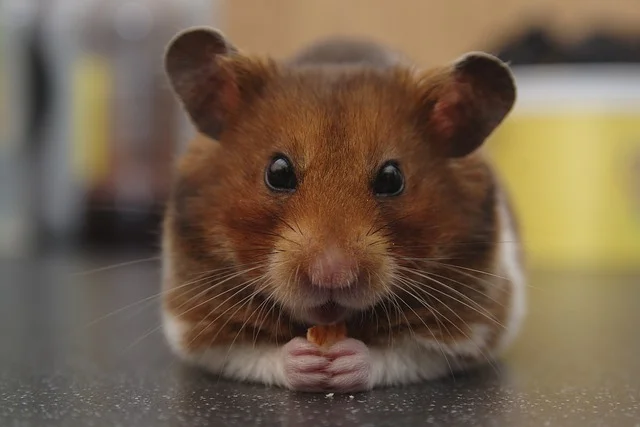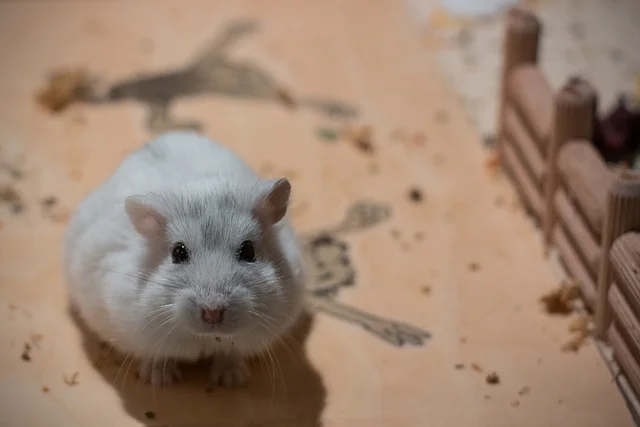Hamsters are adorable and popular pets known for their small size and charming personalities. These furry creatures make excellent companions for people of all ages, from children to adults. Whether you’re a potential hamster owner or already have one, it’s crucial to grasp their diverse types, care needs, breeding habits, food preferences, social interactions, and vaccination requirements. We will explore these aspects in detail, equipping you with the knowledge to become a well-informed hamster owner.
Hamsters are small, furry rodents that belong to the subfamily Cricetinae. These delightful creatures originate from various parts of the world, including Europe, Asia, and the Middle East. They have become popular pets due to their manageable size, low maintenance requirements, and charming personalities.
Types of Hamsters: Which Breed is Right for You?
Syrian Hamsters

Syrian hamsters, also known as golden hamsters, are the most common and widely recognized hamster breed. They are larger than dwarf hamsters and have a solitary nature, preferring to live alone. Syrian hamsters have a variety of coat colors and patterns, making them visually appealing pets.
Dwarf Hamsters

Dwarf hamsters refer to several small hamster species, including Campbell’s dwarf hamsters, Roborovski hamsters, and Winter White Russian dwarf hamsters. Unlike Syrian hamsters, dwarf hamsters can live together in same-sex pairs or small groups. They have distinct characteristics and require specialized care.
Choosing the Right Hamster
When selecting a hamster, consider factors such as the hamster’s breed, age, temperament, and availability. Spend time observing different hamsters to find one that suits your preferences and lifestyle. Ensure that the hamster appears healthy, with clear eyes, a shiny coat, and no signs of illness.
Hamster Care: Creating a Suitable Environment
Proper care and habitat setup are crucial for ensuring your hamster’s well-being. Here are some key aspects to consider:
Cage Selection and Setup
Choose a spacious cage with secure doors and proper ventilation. Provide bedding material to create a comfortable and safe nest for your hamster.
Bedding and Nesting Materials
Select appropriate bedding, such as aspen shavings or paper-based products, that are safe for hamsters. Offer nesting materials like shredded paper or hay for their natural burrowing instincts. Let’s delve into the details of bedding and nesting materials to ensure your hamster’s habitat is just right.
1. Bedding Materials
When choosing bedding materials for your hamster, prioritize safety, comfort, and absorbency. Here are some options to consider:
1.1 Aspen Wood Shavings
Aspen wood shavings are a popular choice among hamster owners. They are safe, absorbent, and provide a soft surface for your hamster to burrow and nest in. Ensure that the shavings are kiln-dried to eliminate harmful oils.
1.2 Paper-Based Bedding
Paper-based bedding is another excellent option. It’s dust-free, highly absorbent, and easy to clean. Look for products made from recycled paper to promote environmental sustainability.
1.3 Coconut Fiber (Coir)
Coconut fiber, often referred to as coir, is a natural and biodegradable choice. It creates a comfortable and cozy environment for your hamster. Coir also has a pleasant earthy scent.
1.4 Corn Cob Bedding
Corn cob bedding is an alternative for hamster owners looking for something different. It is soft, absorbent, and dust-free. However, it’s crucial to monitor your hamster to ensure they don’t ingest it.
2. Nesting Materials
Hamsters love to create cozy nests where they can sleep and feel safe. Providing the right nesting materials is essential for their well-being. Here are some materials your hamster will appreciate:
2.1 Tissue Paper
Tissue paper is a simple and readily available nesting material. Tear it into small strips and place it in your hamster’s cage. They will use it to build their nest.
2.2 Hay or Straw
Hay or straw can also serve as nesting materials. Ensure it’s clean, dry, and free from mold. Your hamster will enjoy the texture and use it to construct their nest.
2.3 Shredded Cardboard
Shredded cardboard is another option. It’s safe for your hamster to chew on, and they can use it to create a cozy hideaway.
2.4 Store-Bought Nesting Material
Pet stores offer a variety of nesting materials specifically designed for hamsters. These materials are often colorful and can add a playful touch to your hamster’s habitat.
Nesting Habits
Understanding your hamster’s nesting habits is essential for providing the right materials. Hamsters are known for hoarding food and nesting materials in their hideouts. They may also shred bedding to create tunnels or line their nests.
Monitor your hamster’s behavior to see which materials they prefer for nesting. Keep their nesting area clean and replace materials regularly to maintain hygiene.
Temperature and Humidity Control
Maintain a suitable temperature range for your hamster, typically between 65°F and 75°F (18°C and 24°C). Avoid exposing them to direct sunlight or drafts. Hamsters prefer moderate humidity levels between 40% and 70%.
Exercise and Playtime
Provide an exercise wheel, tunnels, chew toys, and other interactive items to keep your hamster mentally stimulated. Allow supervised playtime outside the cage in a secure and hamster-proofed area.
Hamsters Diet
A balanced and nutritious diet is essential for your hamster’s health. Here’s what you need to know:
Appropriate Hamster Diet
Feed your hamster a high-quality hamster pellet mix as the primary food source. These pellets provide essential nutrients and prevent selective feeding.
Fresh Food and Treats
Offer fresh vegetables, fruits, and occasional treats in moderation. Avoid feeding them toxic foods like chocolate, onions, garlic, or citrus fruits.
Water Requirements
Ensure a constant supply of fresh, clean water for your hamster. Use a water bottle with a sipper tube attached to the cage to prevent spillage and contamination.
Understanding Hamster Behavior
Hamsters exhibit fascinating behaviors that are important to understand for their well-being:
Solitary Nature vs. Social Interactions
Syrian hamsters prefer a solitary lifestyle and should be housed alone. Dwarf hamsters, on the other hand, can enjoy the company of their kind but require proper introductions.
Nocturnal Habits
Hamsters are nocturnal animals, meaning they are most active during the night. Provide them with a quiet and dimly lit environment during their sleep hours.
Communicating with Your Hamster
Learn to interpret your hamster’s body language and vocalizations to understand their moods and needs. Building trust through gentle handling and interaction is crucial for bonding with your pet.
Breeding Hamsters
Breeding hamsters requires careful consideration and responsible ownership. Here are some essential points to keep in mind:
Breeding Considerations
Research and understand the breeding requirements and genetics of the hamster breed you intend to breed. Ensure both parent hamsters are healthy and free from genetic disorders.
Pregnancy and Birth
Hamster gestation typically lasts between 18 to 22 days. Provide a quiet and comfortable nesting area for the pregnant hamster. Avoid excessive handling during this time to reduce stress.
Caring for Baby Hamsters
Baby hamsters, called pups, are born hairless and blind. Provide a warm and secure nest box for them. Avoid disturbing the nest unless necessary to minimize stress for the mother and pups.
Maintaining Hamster Health
Regular veterinary care and preventive measures are vital for ensuring your hamster’s overall health and well-being:
Regular Vet Check-ups
Schedule routine check-ups with an experienced exotic pet veterinarian to monitor your hamster’s health and detect any potential issues early.
Common Health Issues
Be aware of common health problems in hamsters, including dental issues, respiratory infections, wet tails (severe gastrointestinal infection), and skin conditions. Seek immediate veterinary attention if you notice any signs of illness.
Vaccinations and Preventive Care
Consult your veterinarian about recommended vaccinations and preventive measures to protect your hamster from diseases. Follow a regular cleaning schedule for the cage and maintain good hygiene practices.
Frequently Asked Questions (FAQs)
1. Can hamsters live together?
Hamsters have different social needs. Syrian hamsters should live alone, while dwarf hamsters can live together in same-sex pairs or small groups.
2. What can I feed my hamster besides pellets?
In addition to pellets, you can offer fresh vegetables, fruits, and occasional treats. Ensure a balanced and varied diet.
3. Do hamsters require vaccinations?
Hamsters may require vaccinations against certain diseases. Consult your veterinarian for guidance on preventive care.
4. How long do hamsters live as pets?
The lifespan of a hamster varies depending on the breed and individual health. On average, hamsters live for about 2 to 3 years.
5. Can I breed hamsters as a hobby?
Breeding hamsters requires responsible ownership, adequate knowledge, and proper planning. It is essential to prioritize the welfare of the hamsters involved.
In this comprehensive guide, we have covered various aspects of hamster ownership, including types, care, breeding, food habits, social habits, and vaccines. By following these guidelines and providing a loving environment, you can ensure a happy and healthy life for your adorable hamster companion.
Conclusion
Hamsters make delightful pets with their charming personalities and adorable antics. By understanding their types, care requirements, breeding habits, food preferences, social interactions, and vaccination needs, you can provide a loving and enriching environment for your furry friend. Remember to prioritize their well-being, and offer them a balanced diet. Provide them ample opportunities for exercise and mental stimulation, and seek professional veterinary care when needed.







Leave a Comment
You must be logged in to post a comment.